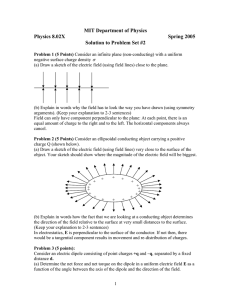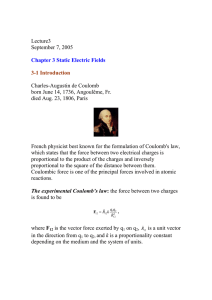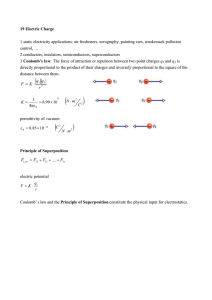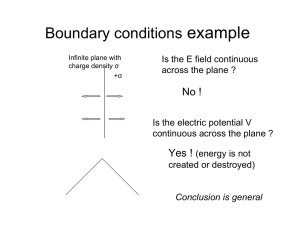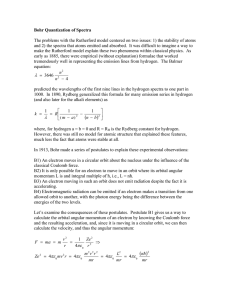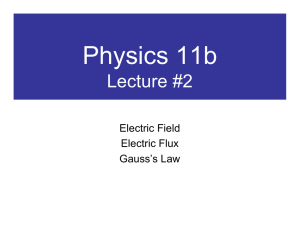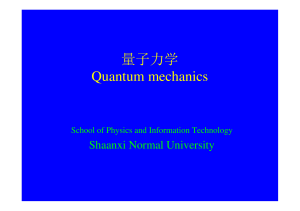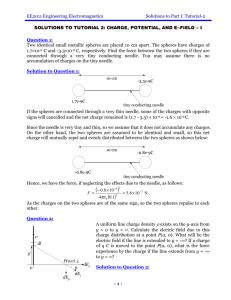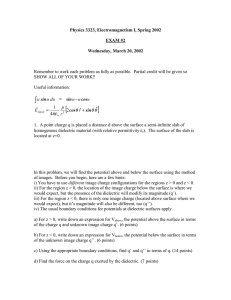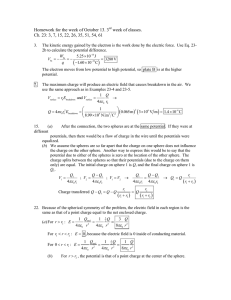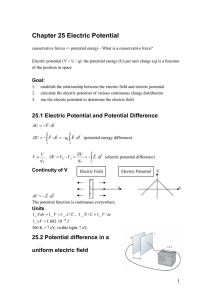∫ Multipole Expansion of the Electrostatic Potential—C.E. Mungan, Spring 1998 V
advertisement
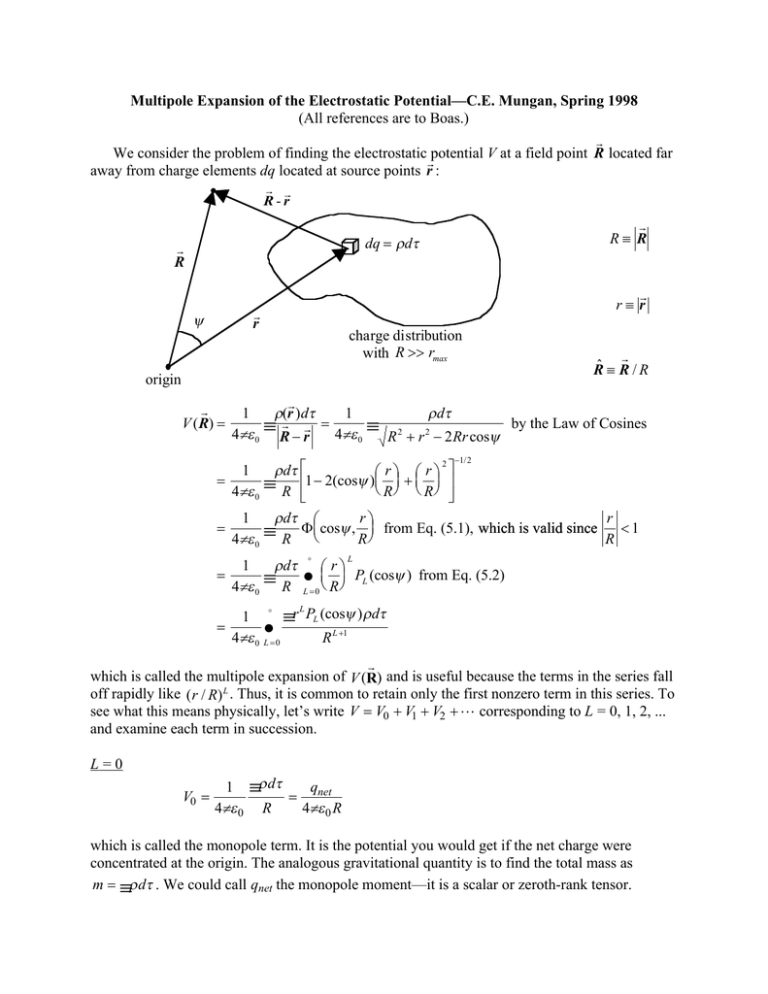
Multipole Expansion of the Electrostatic Potential—C.E. Mungan, Spring 1998 (All references are to Boas.) r We consider the problem of finding the electrostatic potential V at a field point R located far r away from charge elements dq located at source points r : r r R-r r R≡ R dq = ρ dτ r R r r≡ r r r ψ charge distribution with R >> rmax origin r V ( R) = r Rˆ ≡ R / R r 1 1 ρ(r ) dτ ρ dτ r r = by the Law of Cosines ∫ ∫ 2 2 4πε 0 R − r 4πε 0 R + r − 2 Rr cosψ −1/ 2 2 1 ρ dτ r r (cos ) = − + 1 2 ψ R R 4πε 0 ∫ R r 1 r ρ dτ <1 Φ cosψ , from Eq. (5.1), which is valid since = ∫ R 4πε 0 R R = 1 ρ dτ ∫ R 4πε 0 ∞ L r PL (cosψ ) from Eq. (5.2) ∑ L =0 R L 1 ∞ ∫ r PL (cosψ ) ρ dτ = ∑ 4πε 0 L = 0 R L +1 r which is called the multipole expansion of V (R) and is useful because the terms in the series fall off rapidly like ( r / R) L . Thus, it is common to retain only the first nonzero term in this series. To see what this means physically, let’s write V = V0 + V1 + V2 + L corresponding to L = 0, 1, 2, ... and examine each term in succession. L=0 V0 = 1 ∫ ρ dτ q = net 4πε 0 R 4πε 0 R which is called the monopole term. It is the potential you would get if the net charge were concentrated at the origin. The analogous gravitational quantity is to find the total mass as m = ∫ ρ dτ . We could call qnet the monopole moment—it is a scalar or zeroth-rank tensor. L=1 r 1 ∫ r cosψρ dτ but r cosψ = Rˆ ⋅ r 2 4πε 0 R ˆ r r r 1 R ⋅ ∫ r dq but p ≡ ∫ r dq = 2 4πε 0 R r ˆ p⋅R = 4πε 0 R2 V1 = r which is called the dipole term and falls off faster with R than the monopole term. We call p the dipole moment—it is a vector or first-rank tensor. The analogous gravitational quantity is related to the position vector of the center of mass, r r ∫ r dm r≡ ∫ dm r whose components are given by Eq. (5.3.3). That is, p / qnet gives the position of the center of charge. (This implies that the dipole moment is independent of the choice of origin if qnet = 0.) L=2 21 2 1 ∫ r 2 (3 cos ψ − 1) dq V2 = 4πε 0 R3 r but ∫ r 2 (3 cos2 ψ − 1) dq = ∫ [3( Rˆ ⋅ r )2 − r 2 ]dq r r r 3 3 R 3 Rj R r 2 R R 2 R R = ∫ 3 ⋅ r − ⋅ r dq = ∫ 3∑ i ri ∑ rj − ∑ i i r 2 dq R R R i =1 R j =1 R i =1 R R 3 Ri =∫∑ i, j =1 R 3 R (3ri rj − r δ ij ) dq = ∑ i R i, j =1 R Rj 2 [∫ (3rirj − r 2δij )dq] Rj R Let Qij ≡ ∫ (3ri rj − r 2δ ij )dq define the components of a 3 × 3 matrix or second-rank tensor called t the quadrupole moment Q. This quantity behaves like the moment of inertia Iij ≡ ∫ (r 2δ ij − ri rj )dm (cf. Sec. 5.3 and Prob. 10.12.11). Then V2 = 1 2 t Rˆ t × Q × Rˆ 4πε 0 R3 called the quadrupole term, which now falls off like 1 / R 3 . Problems 1. If r U1 t M11 M12 M13 U U = 2 and M = M21 M22 M23 , M31 M32 M33 U3 3 rt t r then verify that U × M × U = ∑ Ui MijU j by explicitly expanding both sides of this equation. i, j =1 2. The Kronecker delta is defined by 1 if i = j δ ij ≡ 0 if i ≠ j where i and j range over the integers 1 to 3, which stand for x to z, in this handout. This gives the components of what well-known matrix? Name it and write it out explicitly. 3. A sphere of radius a centered at the origin carries a volume charge density in spherical coordinates of a ρ = ρ0 2 ( a − 2r )sin θ , r where ρ0 is a constant (with what units?). r Find the approximate potential for points on the z-axis far away from the sphere. Hint: Since R is along the z-axis then ψ = θ and R = z. Check the units of your answer. 4. A spherical shell of radius a centered at the origin carries a surface charge density of σ = k cosθ , where k is a constant (with what units?). (i) Find the dipole moment of this charge distribution. Hint: Find its x, y, and z components and check the units of your answer. (ii) Show that the approximate potential at points far from the sphere is ka3 V ( R,θ R , φ R ) = cosθ R 3ε 0 R2 r where ( R,θ R , φ R ) are the spherical coordinates of R. It turns out that this answer is exact, not approximate, as can be shown with more work—see for example Griffiths e.g. 9 p. 142. 5. Prove in general that the quadrupole moment is independent of the choice of origin if both the monopole and dipole moments of some charge distribution are zero. (This works all the way up the hierarchy—the lowest nonzero multipole moment of any distribution is independent of origin, while the higher multipole moments r in general are not.) Hint: Shift the origin from 0 to r r r r r shifts to r = r − d , where d is the vector connecting 0 to 0 ′ . Now compute Qij′ and 0 ′ so that ′ show that it equals Qij. 6. Find the quadrupole moment (i.e., write out all 9 components in matrix form) for the charge distribution depicted below, if the square has sides of length s and lies in the xy-plane. (According to problem 5 you can, without loss of generality, take the square to be centered at the origin.) Hint: The integral becomes a sum over the four charges, where r1 , r2 , and r3 equal the x, y, and z components of the position of a charge. –q +q +q –q
